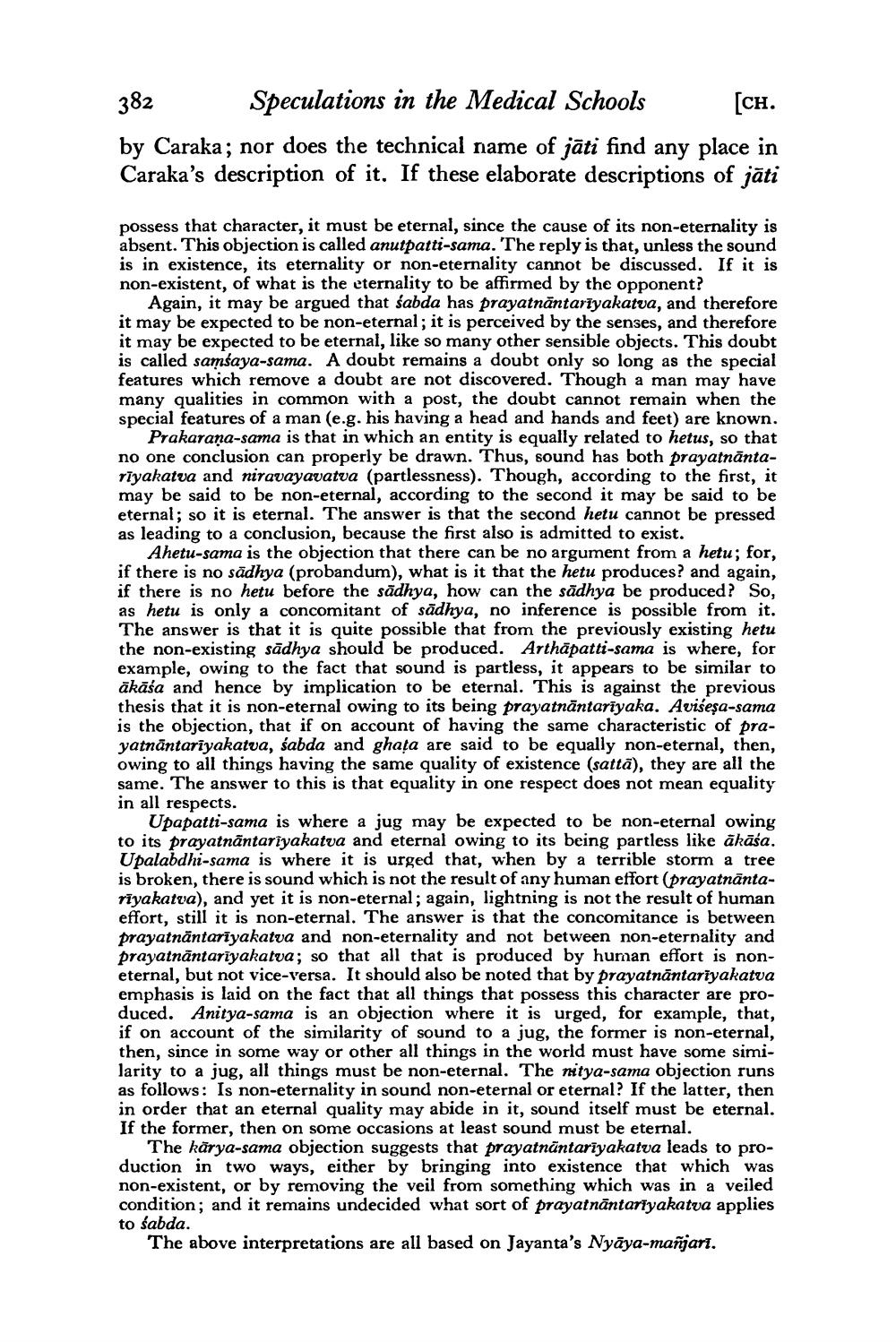________________
382 Speculations in the Medical Schools [ch. by Caraka; nor does the technical name of jāti find any place in Caraka's description of it. If these elaborate descriptions of jāti
possess that character, it must be eternal, since the cause of its non-eternality is absent. This objection is called anutpatti-sama. The reply is that, unless the sound is in existence, its eternality or non-eternality cannot be discussed. If it is non-existent, of what is the eternality to be affirmed by the opponent?
Again, it may be argued that sabda has prayatnāntariyakatva, and therefore it may be expected to be non-eternal; it is perceived by the senses, and therefore it may be expected to be eternal, like so many other sensible objects. This doubt is called samsaya-sama. A doubt remains a doubt only so long as the special features which remove a doubt are not discovered. Though a man may have many qualities in common with a post, the doubt cannot remain when the special features of a man (e.g. his having a head and hands and feet) are known.
Prakarana-sama is that in which an entity is equally related to hetus, so that no one conclusion can properly be drawn. Thus, sound has both prayatnāntarīyakatva and niravayavatva (partlessness). Though, according to the first, it may be said to be non-eternal, according to the second it may be said to be eternal; so it is eternal. The answer is that the second hetu cannot be pressed as leading to a conclusion, because the first also is admitted to exist.
Ahetu-sama is the objection that there can be no argument from a hetu; for, if there is no sādhya (probandum), what is it that the hetu produces? and again, if there is no hetu before the sādhya, how can the sādhya be produced? So, as hetu is only a concomitant of sādhya, no inference is possible from it. The answer is that it is quite possible that from the previously existing hetu the non-existing sādhya should be produced. Arthāpatti-sama is where, for example, owing to the fact that sound is partless, it appears to be similar to ākāśa and hence by implication to be eternal. This is against the previous thesis that it is non-eternal owing to its being prayatnāntarīyaka. Aviseşa-sama is the objection, that if on account of having the same characteristic of prayatnāntariyakatva, sabda and ghata are said to be equally non-eternal, then, owing to all things having the same quality of existence (sattā), they are all the same. The answer to this is that equality in one respect does not mean equality in all respects.
Upapatti-sama is where a jug may be expected to be non-eternal owing to its prayatnāntariyakatva and eternal owing to its being partless like ākāśa. Upalabdhi-sama is where it is urged that, when by a terrible storm a tree is broken, there is sound which is not the result of any human effort (prayatnāntariyakatva), and yet it is non-eternal, again, lightning is not the result of human effort, still it is non-eternal. The answer is that the concomitance is between prayatnāntariyakatva and non-eternality and not between non-eternality and pravatnāntariyakatva; so that all that is produced by human effort is noneternal, but not vice-versa. It should also be noted that by prayatnāntariyakatva emphasis is laid on the fact that all things that possess this character are produced. Anitya-sama is an objection where it is urged, for example, that, if on account of the similarity of sound to a jug, the former is non-eternal, then, since in some way or other all things in the world must have some similarity to a jug, all things must be non-eternal. The nitya-sama objection runs as follows: Is non-eternality in sound non-eternal or eternal? If the latter, then in order that an eternal quality may abide in it, sound itself must be eternal. If the former, then on some occasions at least sound must be eternal.
The kārya-sama objection suggests that prayatnāntarīyakatva leads to production in two ways, either by bringing into existence that which was non-existent, or by removing the veil from something which was in a veiled condition, and it remains undecided what sort of prayatnāntariyakatva applies to sabda.
The above interpretations are all based on Jayanta's Nyāya-mañjari.




